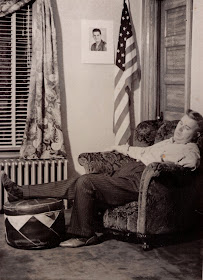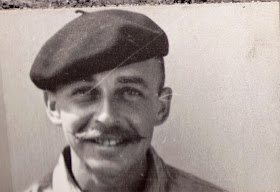Pages
▼
Wednesday, December 10, 2014
Tuesday, November 25, 2014
OSS CBI Photobook 15 - Southwest China, 1945- Reconnaissance, Part 3, The Rifle Strap
Lingering still on the top half of Photobook page 15, we focus on this excellent view of gear. The posed photo of our EJZ, showing how the OSS looks for bad guys in caves, also shows us that the unit is still in wait-and-prepare mode at this point. So look at the items: rifle with strap, pistol in holster, either a US M3 fighting knife or US M4 bayonet with the hilt visible behind the holster, and a magazine pouch mounted on the stock. A 15-round magazine is visible just below the sight.
The rifle is a .30 Caliber M1 carbine.
What is that vertical thing on the side of the stock?
And, dangling down from our view of the holster, hence attached either to the holster, or to the bayonet or knife, is a strange thing with strings dangling off it. What is it?
The photo below, illustrating a US Army paratrooper's kit, is from Philip B. Sharp's 1938 The Rifle in America. The paratrooper's M1 carbine is a little shorter than the standard M1 rifle that ground troops would carry, according to the text. It does not look exactly the same as the carbine carried by Pfc Eugene Zdrojewski: the vertical thing on the stock looks different. It is an "M11903A1."
But look, you can see very well how the strap attaches to the rifle.
In the paratrooper's kit, above, from Sharp's book, it is clear that the knife is different; the ammunition pouch looks similar; those two empty pouches (above the grenades and to the left of the gloves) look very familiar, don't they; the binoculars case looks exactly like the one on the kitchen windowsill of the Marilla house - how about that.
The holy Wikipedia article has a very clear photo of the M1 rifle and the M1 carbine:
 |
| Wikipedia: "Carbine." |
We have seen this type of carbine before, from Photobook Page 3, of training near U Chicago in the summer of 1944. By the time our EJZ gets to China, he has been training with this rifle for a year and a half.
 |
| From Photobook Page 3. |
 |
| Again from Photobook Page 3. |
We have the strap from Dad's M1 carbine.
Marty and I - nosy kids - always knew it was there in his closet, way over on the right, by his neckties, looped around one of those skinny white coat hangers. We thought nothing of it.
Then the day came when we emptied the Marilla house, and there it still was.
When Gene came home, for the rest of his life he went to sleep with his rifle strap no more than 12 feet from his hand.
Z
Sunday, November 23, 2014
OSS CBI Photobook 15 - Southwest China, 1945- Reconnaissance, Part 2, Is this "Frenchie?"
Last post included this photo of a man in Dad's unit:
Surely, Lt. Robichaud is "Frenchie." Here it is, 2014, and the heirs of our own EJZ finally figure this out. Would that these two have both lived long enough to have found each other, emailed each other, and arranged a meetup here on Earth. It is heart-rending to realize that that almost happened, but did not.
So, all right, we shall try to find this Lieutenant Albert, and what we find we shall report.
In the meantime, restful dreams, to them both.
Z
So far there is nothing found in the Trove that gives a clue to his identity. However, several sleepless nights and absent-minded days have brought back a memory that might pertain to this man. I remember Mom explaining to us kids about the nightmares Dad would have fairly often. Obviously he was reliving skirmishes in his dreams. One recurring line was:
"Hey, Frenchie! Look out! Look out, Frenchie!!"
Mills, Mills, and Brunner's 2002 OSS Special Operations in China introduces Team Jackal, including a subgroup, or "echelon," consisting of "Zarembo, . . . Robichaud . . . and . . . Zdrojewski."
For the moment we will concentrate on the introduction therein to Lieutenant Albert Robichaud. He had "completed two operational missions behind the lines in France, testing circuits of the clandestine travel routes operated by the combined ODD/British SOE 'DF Section' for Western Europe that were used to move people, equipment, money, and messages between Europe and London. The most important function was to move secret agents working for the British and OSS into France and other countries and to bring them out again to the London headquarters. The travel nets were also used for the return to England of downed airmen from the air attacks over Western Europe. So Lieutenant Robichaud was another combat OSS veteran redeployed from operations in France and a welcome addition to the team." (Mills, Mills, and Brunner, 2002, p. 83-84.)
So, all right, we shall try to find this Lieutenant Albert, and what we find we shall report.
In the meantime, restful dreams, to them both.
Z
Sunday, October 19, 2014
OSS CBI Photobook 15 - Southwest China, 1945- Reconnaissance, Part 1
These scenes are still in or near the KMT HQ we have featured in recent posts. We need to figure out precisely where this is.
The style of photomontage used here, with no margins and with prints cut at various angles, is reminiscent of what we have seen in the Kensington High yearbook design and the St. Luke's youth group newsletter. Apparently it was popular in the 1940s. Who did all this cutting and pasting for this photobook? Dad? His father, our JPZ? Mom? Mom having done it would explain all the photos of Dad!
Detailed information about the terrain was vital to planning airstrips and a possible future land invasion, the latter a dreadful prospect. The photo team does not appear to have wide-angle lenses. They take a series, note the exposure numbers, and cut and paste prints together to produce a wide view of terrain.
Posed shots like the one below are hints that they have a lot of time on their hands. No doubt they also need to adapt their techniques to local conditions of light and dust, set up their darkroom facilities, and decide on the best developing and printing techniques.
They are also making contact with local Chinese, setting up training sessions, setting up reconnaissance missions and protocols for reporting, and recording terrain farther and farther out from base.
Who is this? Who is this?
"Wartime Series" Post of May 12, 2012 - in re Grandfather Clock
Putting up the grandfather clock photos recalled the May 2012 post "Wartime Series."
I ran across those prints again, and wanted to show them to you before I file them away. Matter of fact, they are now in a Ziploc baggie along with a little piece of paper that says "Wartime Series." Hey, I'm not going to live forever - who does? - so, heirs and descendants, understand and appreciate these artifacts, and take care of them.
In the meantime I shall bend every effort to solve the mysteries involved, as and when possible.
Deal? Good.
 |
| JPZ - EJZ - USA |
Saturday, October 18, 2014
Grandfather Clock, Then and Now
John Peter Zdrojewski, our JPZ, came to America on the boat in 1903 with his parents, Ludwig and Victoria Zdrojewski. As a young man in Buffalo, he worked for a time in a carpentry shop. We have a photo of the crew in the shop. JPZ is second from right, identified for us by his son John, our JFZ.
John Peter built a grandfather clock, a "case clock," at home. Family legend has him just finishing it up on the kitchen table when his firstborn, Eugene, our EJZ, was born in the next room. That was October 7, 1923.
So it was always in the house, on St. Louis Street and then on May Street, in Buffalo. Below we see Eugene home from Orchard Lake - high school? or college? - at Christmastime. The grandfather clock is in the background, obscured by that lamp.
In 1940, JPZ's younger brother Casimir Zdrojewski and his wife Cecelia brought their firstborn, Paul, to visit. Here is the photo of the young family seated by the grandfather clock.
During World War II, while Eugene was away 1943-1945, JPZ made a photo series about being a parent on the home front. We have seen the photo below, here and also here. This is the best photo we have found so far of that clock.
The grandfather clock moved to the Marilla house some time after its completion in 1957. We have yet to find a photo of that clock in its place in the Marilla house! That is a shock. With luck we will find some. It was important; it was a fixture; so where are the pictures?
In the 1980s Gene and Clara took the clock to somebody for refinishing. We have a couple of Polaroids from their visit to the clock while it was in rehab. Tye found them inside the case.
When the Marilla house was closed in 2008, the clock went to its new home with Tye and Kim Zdrojewski. Thanks, Tye, for the photos.
The old, dark varnish had historic-sentimental value, but the new finish shows off the wood so much better. Looks like curly maple, doesn't it?
 |
| A treasure beyond price. |
Friday, October 17, 2014
Tom Thomson
Oh, I am so proud of the right sidebar at Gene & Clara's. Just look at all that great stuff. "Happening Recently Enough in Argyle, New York" is set just above the clickable list of labels. Right now we feature a painting by Tom Thomson.
Algonquin country, now Ontario's Algonquin Provincial Park, was his stamping ground. His best paintings date from 1914-1917.
I was there, in Algonquin, on a canoe trip, in July 1969. In a place that looked a lot like that (except for the snow) I looked up at the moon, where the crew of Apollo 11 were making the first landing.
Bit of a loner Thomson was, perhaps a bit of a misfit, and his death while out in a canoe on his favorite waters remains a mystery.
Monday, October 6, 2014
Sunday, October 5, 2014
Saturday, October 4, 2014
OSS CBI Photobook 12, Part 2 - Koumintang 1945, continued
 |
| Kachin? Jingpo? Singpho? |














































